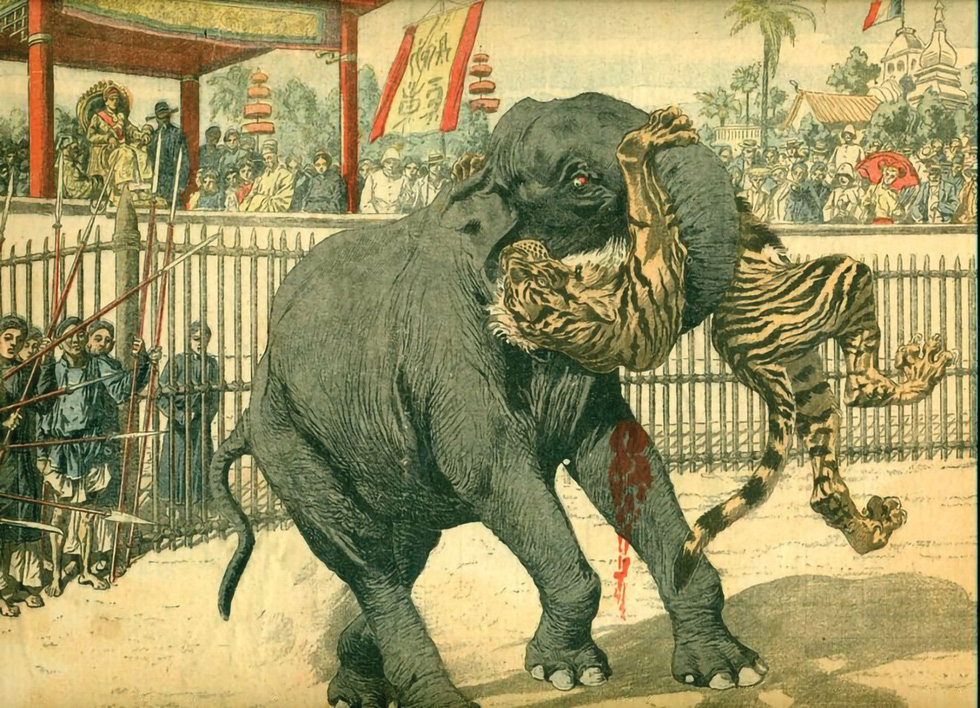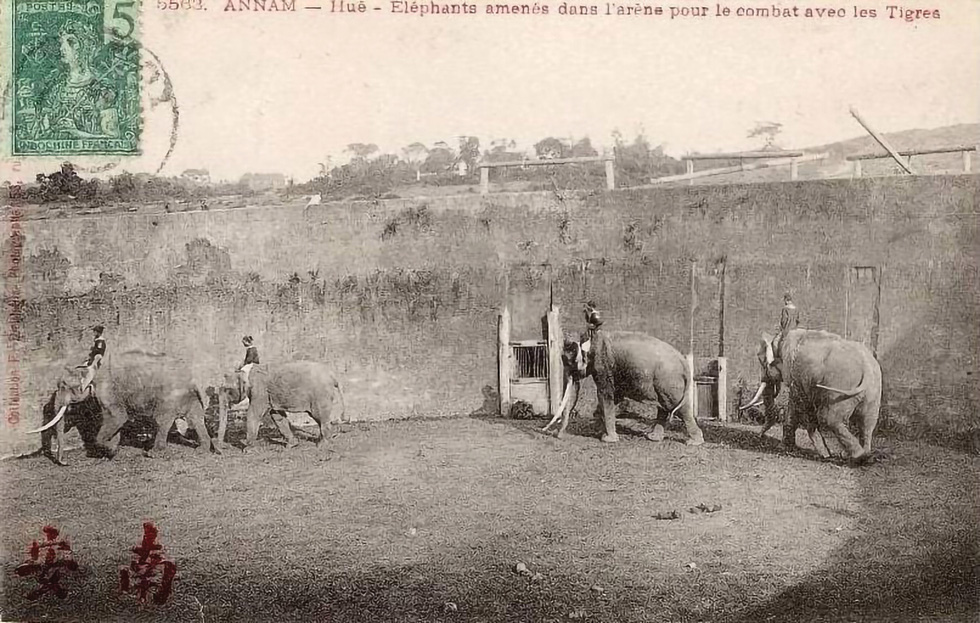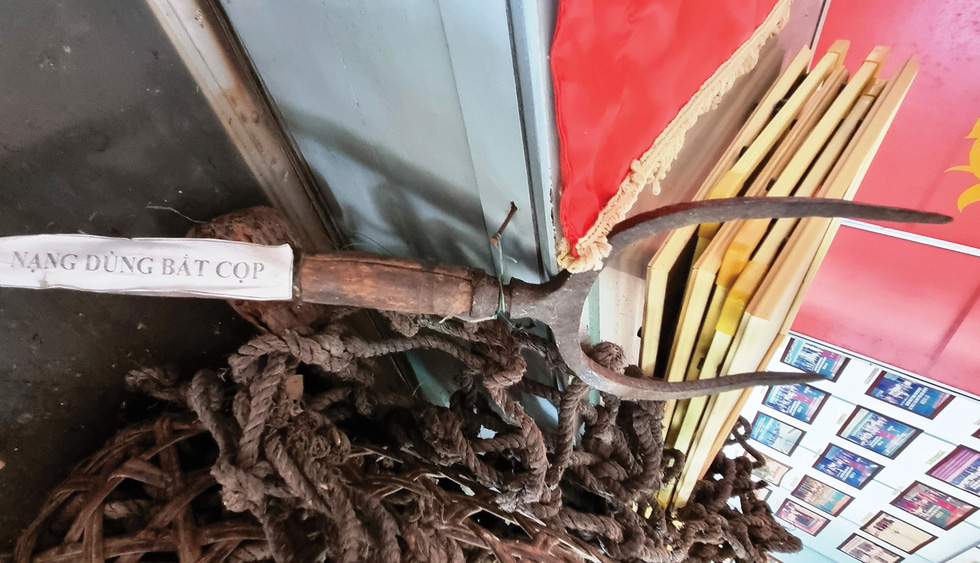While there are many ancient villages in Vietnam that specialize in a single profession, there is just one village that is famous for something unique: catching the 'king of the jungle.'
The village of Thuy Ba is located in what is now the central province of Quang Tri.
The villagers are so proud of their ancestors that they point out their past to visitors right at the main gate leading into Vinh Thuy Commune in Vinh Linh District.
"Thuy Ba is famous for catching tigers - Vinh Thuy is known as a hero community," reads the saying on the gate.
Indeed, stories about wild tigers were popular throughout Vietnam in the twentieth century.
While in the northern area the phrase 'Bao Ha tigers, Trai Hut spirits' refers to two places in Lao Cai Province, in the south-central region it says 'Khanh Hoa tigers, Binh Thuan spirits' and in Quang Tri it is 'Thuy Ba tigers, Tro Ro spirits.'

Centenary nets made from Gnetaceae tree
The stories of Thuy Ba villagers who caught wild tigers are well documented. They were told by the remaining tiger hunters many years ago.
Unfortunately, Nguyen Dinh Hap, the last surviving tiger hunter of Thuy Ba, died about six months ago.
Although it is called 'a village,' Thuy Ba is the name of a vast area in the southwest of Vinh Linh District, which now includes Vinh Lam, Vinh Son, and Vinh Thuy Communes.
According to its history, the village was founded in the eleventh century by soldiers who took part in the conquest of the southern area by Ly Thuong Kiet's troops.
Ly Thuong Kiet of the Ly Dynasty was one of the greatest generals in Vietnamese history who helped the country defeat the Chinese Song Dynasty in the 11th century.
Thanks to the many dense jungles and swampy areas, Thuy Ba was also a haven for tigers.
At first, the tigers only caught the villagers' livestock such as water buffaloes and cows. Later, they started hunting around houses to catch pigs, dogs, and then humans.
It was time for Thuy Ba villagers to organize hunters to catch the 'king of the jungle.'
Visitors to Thuy Ba Village today can see the nets and tridents that villagers used to catch tigers. The nets were made from Gnetaceae plants, whose fruits are the tigers' favorite.
"There are no climbing plants as soft and flexible as Gnetaceae," explained Nguyen Quang Chien, head of Vinh Thuy Commune.
"It would be impossible for tigers to tear the net with their teeth," he continued, adding that because of this property, the climbing plant was often used to weave nets for catching tigers in the past.
To make the net, tiger hunters would cut down the climbers, shred them, and soak them in lime water for several weeks to get rid of the wood fibers.
The remaining fibers were collected into finger-thick threads and then woven into nets along with ratan plants. Each net is about 8-12 meters long and 3-4 meters wide.
Thuy Ba Village was first divided into two hamlets: Thuy Ba Thuong and Thuy Ba Ha. Later, Thuy Ba Thuong was further divided into two parts: Thuy Ba Dong and Thuy Ba Tay, and then there were three hamlets in total, namely Ha - Dong - Tay.
In each hamlet, there were 20 teams of ten to a dozen people who prepared to catch tigers with 4-6 nets.
All male adults 17 years old and above were required to participate in tiger catching except children from wealthy families who excelled at learning.

How to catch a wild tiger
Anyone who finds tiger tracks reports to the head of the hunting ward as soon as possible.
When the news arrives, the leader of a team calls the members together and designates one person to be responsible for tracking the tiger.
Not just anyone can be assigned to this task. They must be highly experienced tiger hunters who have a good sense of where the tiger might be and the specific areas that need to be covered to catch it.
In fact, the ability to track the tiger is a special skill that would often be passed down from generation to generation in a family.
This is not surprising, as a person who is good at it can tell many things from the tiger's remaining tracks.
They can tell exactly how big the tiger is, whether it is dangerous or friendly, and how far away it might still be.
Once the tracker figures out where the tiger is, the village holds a sacrificial ritual in which a male chicken is killed and its legs are taken to predict whether or not the plan to capture the tiger might succeed.
After the ritual ceremony, the community leader assigns teams to set nets in specific areas identified by the tracker.
Such areas are sometimes as large as two hectares, leaving about a quarter of the circle as a 'gate.'

Most of the trees in the area are later cut down, including the tall ones, to prevent the tiger from climbing the tree to free itself while trapped in the net.
While the team surrounds the big cat, another team stands by outside the net to be prepared for any unexpected situation.
At the same time, other members, who are considered the bravest, face the tiger directly inside the area covered by the nets.
Amid the noise of bells and drums beaten by villagers, the leader of the division shouts loudly, "Thuy Ba alll stand up! Our shouts cause the tiger to wake up!" The statement is echoed by many shouts from the surrounding villagers.
Along with the loud shouts, the tiger hunters will shrink the circle to get closer to the animal. Cornered, the tiger becomes more and more aggressive and dangerous. Often, the big cat remains still in a bush and then lunges at the hunters in surprise.
In the final phase of the hunt, the members of the hunting ward are no longer afraid of the tiger.
They shout and beat the drum and the bell to break the tiger.
The 'king of the jungle' finally gives up although his disappointing cries can make anyone's hair stand on end.
After the tiger has been left alone in the nets for four to five days, it becomes hungry and loses strength so the tiger hunters take it to a large cage made of rattan.
When they successfully catch the tiger, the village officials perform another sacrificial ritual with a male chicken to thank their ancestors for helping them catch the animal.
The village went down in history
The fame of Thuy Ba spread to Hue City, where the central government was located at that time.
When tigers devastated the western part of the city, the king asked the tiger hunters of the village for help.
In 1830, Emperor Minh Mang built Ho Quyen, a colosseum where elephants and tigers could fight each other.
Thuy Ba Village became one of the few sources that supplied tigers for this facility.
Today, Ho Quyen is a historical site that belongs to the Hue Monuments Complex, a World Heritage Site recognized as tangible heritage by UNESCO in 1993.
In recent years, the number of wild tigers in Vietnam has declined rapidly and there are currently none left in the wild.
Accordingly, the nets and tridents used to catch tigers in the past are displayed in the community's traditional house to remind younger generations of their ancestors' heroic feats in subduing the 'king of the jungle.'
Like us on Facebook or follow us on Twitter to get the latest news about Vietnam!


















































